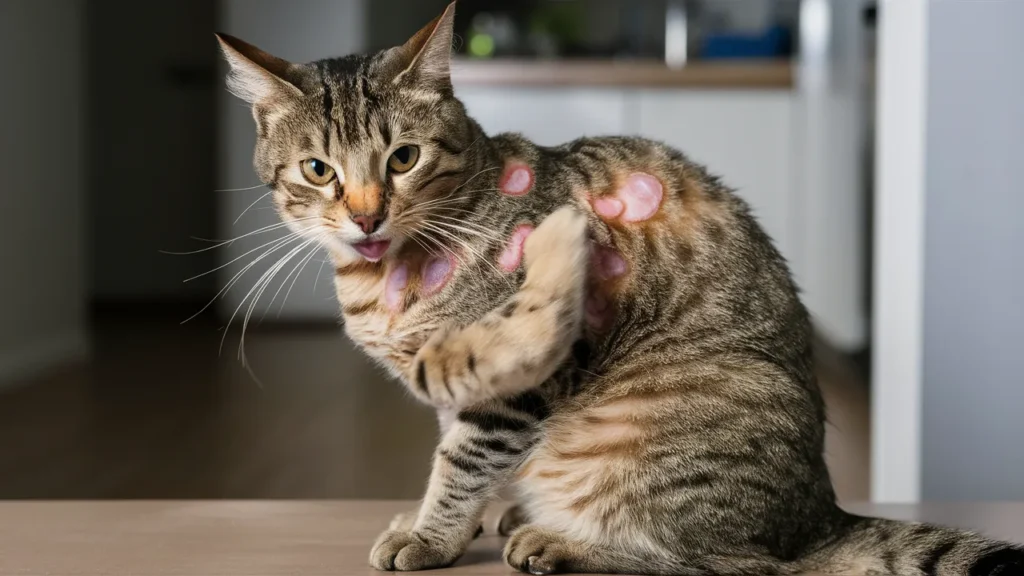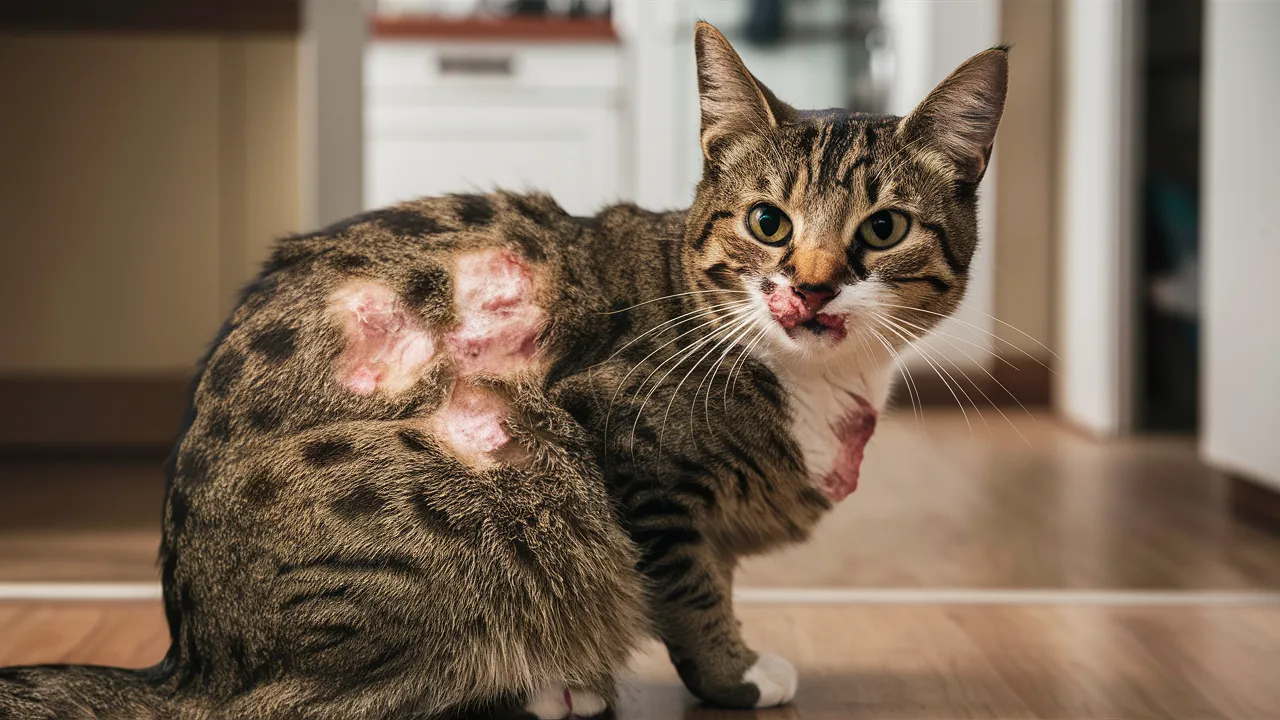Scabby Cat Disease:
Introduction to Scabby Cat Disease
Scabby cat disease might sound like a scary term, but understanding it is the first step towards managing and preventing it. Essentially, it’s a general term used to describe various skin conditions in cats that result in scabs, itching, and discomfort. Knowing what causes these symptoms and how to treat them can greatly improve your cat’s quality of life.
Causes of Scabby Cat Disease
Common Causes
Scabby cat disease can be caused by a multitude of factors. One of the most common causes is flea allergy dermatitis. Even a single flea bite can trigger a severe allergic reaction in some cats, leading to intense itching and scabbing.
Underlying Health Conditions
Apart from flea allergies, other health conditions such as food allergies, environmental allergies (like pollen or dust), and bacterial infections can also lead to scabby skin in cats. It’s important to identify the root cause to treat the condition effectively.
Symptoms to Look Out For
Visible Symptoms
The most obvious symptoms of scabby cat disease are scabs and sores on the skin. These are often accompanied by redness, inflammation, and hair loss around the affected areas.

Behavioral Changes
Cats suffering from this condition may also show behavioral changes such as increased scratching, licking, or grooming of the affected areas. They might become more irritable or withdrawn due to the discomfort.
Types of Scabby Cat Disease
Flea Allergy Dermatitis
Flea allergy dermatitis is a hypersensitivity to flea saliva, causing severe itching and scabbing. Even a few flea bites can trigger a strong reaction in sensitive cats.
Food Allergies
Cats with food allergies may experience skin issues. Common allergens include certain proteins found in chicken, beef, dairy, and fish.
Environmental Allergies
Cats can be allergic to various environmental factors like pollen, mold, dust mites, and certain cleaning products. These allergies often lead to skin irritation and scabbing.
Bacterial Infections
Secondary bacterial infections can develop if a cat’s skin is broken from scratching or biting. These infections can exacerbate the symptoms and cause additional discomfort.
Diagnosis
Veterinary Examination
If you suspect your cat has scabby cat disease, a visit to the vet is essential. The vet will perform a thorough examination to determine the cause of the symptoms.
Diagnostic Tests
Diagnostic tests such as skin scrapings, allergy tests, and blood tests may be required to identify the underlying cause and guide treatment options.
Treatment Options
Medical Treatments
Treatment depends on the underlying cause. For flea allergies, flea control is crucial. This may involve using flea preventatives on the cat and treating the home environment. For other allergies, identifying and eliminating the allergen is key. Antibiotics or antifungal medications may be prescribed for bacterial or fungal infections.
Home Remedies
In addition to medical treatments, some home remedies can provide relief. These include oatmeal baths to soothe irritated skin and using hypoallergenic shampoos to reduce allergens.
Preventive Measures
Regular Veterinary Check-ups
Regular check-ups with the vet can help catch and treat skin conditions early, preventing them from becoming severe.
Proper Hygiene and Grooming
Maintaining proper hygiene and grooming is essential. Regular brushing helps remove loose fur and prevent matting, which can contribute to skin issues.
Diet and Nutrition

Importance of a Balanced Diet
To keep your skin and coat in good condition, you must eat a balanced diet. Ensure your cat is getting all the necessary nutrients, including essential fatty acids which promote skin health.
Foods to Avoid
Avoid feeding your cat foods that are known to cause allergies. If your cat has food allergies, your vet might recommend a special diet to identify and eliminate the allergens.
Living with a Cat with Scabby Cat Disease
Managing Symptoms at Home
Managing symptoms at home involves regular grooming, maintaining a clean environment, and using prescribed medications or treatments as directed by the vet.
Creating a Comfortable Environment
Creating a stress-free and comfortable environment is important. Provide your cat with a cozy, clean space to rest and ensure they have plenty of mental and physical stimulation.
Common Misconceptions
Myths about Scabby Cat Disease
There are many misconceptions about scabby cat disease, such as the belief that it is always caused by poor hygiene or neglect. In reality, even well-cared-for cats can develop skin issues due to allergies or other health conditions.
Facts vs. Fiction
Understanding the facts about scabby cat disease helps in managing it better. It’s not a sign of poor pet care but rather a condition that requires proper diagnosis and treatment.
When to See a Vet?
Signs that Require Immediate Attention
If you notice severe symptoms like extensive hair loss, open sores, or signs of pain and distress, it’s important to see a vet immediately.These might indicate a dangerous underlying illness.
Long-term Health Monitoring
Regular monitoring of your cat’s health is essential, especially if they have a history of skin issues. Keep an eye out for any changes in their skin or behavior and consult your vet if you have concerns.
Impact on Cat’s Quality of Life
Physical Health
Scabby cat disease can significantly impact a cat’s physical health, causing discomfort and pain. Effective management and treatment are crucial for maintaining their well-being.
Emotional Well-being
The emotional well-being of a cat with scabby cat disease is also affected. Chronic itching and discomfort can lead to stress and anxiety. Providing a loving and supportive environment helps in their recovery.
Conclusion
Understanding scabby cat disease is the first step towards helping your feline friend. By recognizing the symptoms, seeking veterinary care, and following the recommended treatments, you can ensure your cat leads a healthy and happy life. Remember, early intervention and consistent care are key to managing this condition effectively.In this way you can prevent your cute cats.
FAQs
-
What is the main cause of scabby cat disease?
- The main cause can vary but often includes flea allergy dermatitis, food allergies, environmental allergies, and bacterial infections.
-
Can scabby cat disease be cured?
- While it may not be completely curable, it can be effectively managed with proper treatment and care.
-
Is scabby cat disease contagious to other pets?
- It depends on the cause. For instance, flea infestations can spread to other pets, but most allergies are not contagious.
-
What home remedies can help soothe my cat’s skin?
- Oatmeal baths and hypoallergenic shampoos can help soothe irritated skin. Consult your veterinarian before attempting any new treatments.
-
How can I prevent scabby cat disease?
- Regular vet check-ups, maintaining a clean environment, and ensuring your cat has a balanced diet are key preventive measures.
